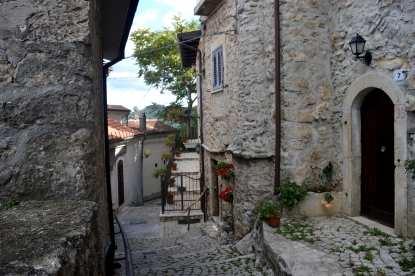Participation in the public and free Wifi Italia network is a way for our administration to participate in the digitization process of the country and enhance our history.
Scontrone is a town made up of two small villages surrounded by nature and rich in art, history and traditions. The territory begins to tell us its history thanks to the geo-paleontological site discovered in the nineties. This site made it possible to study what the natural environment of Scontrone was millions of years ago and what its characteristics were. In the small documentation center connected to the site, it is possible to find the remains of primitive artiodactyls such as the Hoplitomeryx, a ruminant with 5 horns, giant insectivores, crocodiles, turtles and other interesting animals that once made up the fauna of these places.
In ancient times, the territory of Scontrone was certainly linked to the history and events of Aufidena, an important Samnite center of which a vast necropolis and the remains of an acropolis remain in nearby Alfedena. Recently in Campo Dragone in Villa Scontrone tombs with funerary objects dating back to the Samnite and Roman period have been found. These finds, now partially visible in a special exhibition room, are added to the sporadic findings of previous years, always in the surroundings of the town of Villa Scontrone, which testify to the ancient origin of these places.
In the late ancient and medieval era, the political instability of the territory, the Saracen raids and the balance of power of the feudal lords pushed the village to a more defensive aspect and forced it to follow the mixed fortunes of the local lords. This, however, is also a period of great religious ferment in which the cults of the patron saints of daily and peasant life take root in the territory.
The church of Santa Maria Assunta is medieval, remodeled several times following the earthquakes with which the village has always had to live. Originally it was embellished with frescoes that were lost, covered during the consolidation works following the earthquakes of 7 and 11 May 1984. Today part of these frescoes is finally coming back to light thanks to a skilful restoration work. Between the rural churches and the small monasteries of this era we find San Michele Arcangelo probably the oldest church, linked to the presence of the Lombards in the area. The cult of the warrior archangel who defeats the dragon finds great diffusion in popular beliefs overlapping the ancient cult of Hercules with whom it shares various characteristic features. And again San Giovanni d’acqua putida which later changed its name to San Giovanni d’acqua holy, names that refer to the sulphurous water source that flows not far from its ruins and its beneficial properties. Tradition has it that Fra Pietro da Morrone stopped here before becoming Pope Celestino V.
In 1943, during the terrible years of the Second World War, Scontrone found himself along the Gustav Line, the front line that divided the German army from the allied one. In October of that year the village was hit by an aerial bombardment that caused several civilians, many of them children, and those who had chosen Scontrone as a refuge. From this deep wound the town got up rolling up its sleeves and rebuilding stone by stone.
In the 1980s, the first murals appeared, which were then extended to cover the entire village. Here are represented some of the salient moments of the history of Scontrone and its people. The peasant life overlooking the Regio tratturo Pescasseroli-Candela that flows at its feet, marking its events, relationships and rhythms in the modern age and the great history of emigration in the late nineteenth century that saw the houses empty of those young people who left the world known for chasing the dream of a new life.
Today Scontrone is an enchanting and hospitable town that has managed to preserve and rework its history and traditions, becoming an open-air museum.
